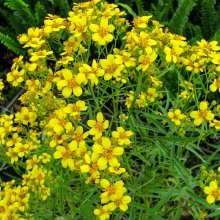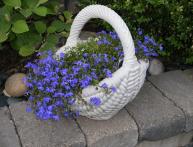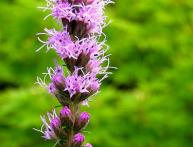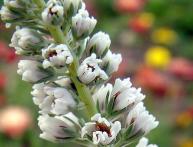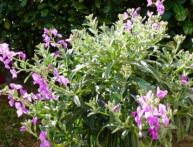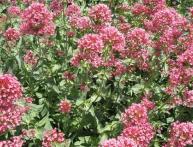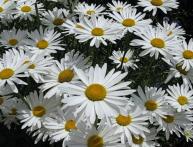Growing a decorative string of bidens
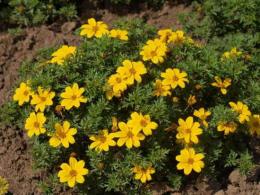
Bidens or string is known to many as a herb, the decoction of which has long been used to bathe children. This is a three-part series. It is widely used for various skin rashes, diaper rash, and prickly heat in babies. There is probably no such wasteland or roadside where there would not be a line. It turns out that among the relatives of this plant there is another series - this is the feruleleaf series.
IN decorative In gardening, the plant appeared under the name bidens a little more than 20 years ago. Therefore, this type of string is not yet as widely known as the tripartite string, but it is gaining popularity in decorative floriculture. Every year, the bidens feruleleaf plant, thanks to its characteristics, is gaining more and more fans and is becoming indispensable for landscaping areas, patios, and loggias.
Content:
Where to plant bidens ferulefolia
If for a garden or balcony you need a plant that, blooming at the end of spring, will bloom profusely until winter, then you need to select and plant a decorative row or bidence. Currently, there are ampelous forms suitable for flowerpots, flowerpots and containers, tall varieties, up to 1.0 m in height, such plants are suitable for single, border and group plantings in the garden. The homeland of this flower is the south of North America and the countries of the central part of the American continent. There bidens exists in a perennial herbaceous form.
In our climate, the plant is most often grown in an annual or biennial form. Bidens has well-branched bushes. The height of the flower varies from 0.5 to 0.9 meters and during the flowering season it is dotted from top to bottom with yellow baskets of inflorescences up to 4 cm in diameter. Where can you plant this wonderful flower?
Choosing a place for bidens
The plant is extremely unpretentious. For his growing A well-lit place with light, sandy or sandy loam soil is ideal. Although the bushes of the plant develop well on any garden soil and in slight shade.
The plant is very resistant to drought and can tolerate low temperatures. We can say that bidens have no special requirements for watering, temperature, lighting and soil. Given its high tolerance to pests and diseases, the plant belongs to the category of those that are planted and forgotten.
How and when to plant bidens
If there is already bidens on the site, you can try to propagate it by cuttings or dividing the bush. In the case where self-seeding has occurred, young plants that have grown independently are used for planting. However, if bidens is grown for the first time, you need to purchase its seeds for planting.
The best time to plant a decorative row is spring. The best way to grow it is by sowing seedlings. To get flowering bidens bushes in early June, sow on seedlings must be done no later than the first ten days of March.
Growing decorative succession through seedlings
Any ready-made soil mixed 1 to 1 with sand is suitable for the plant. You can prepare garden soil in advance and combine it with sand before planting. The resulting soil mixture is filled with seedling boxes. Before sowing, the soil is moistened.The seeding depth is 1.0 cm. The top of the box is covered with glass and transparent film.
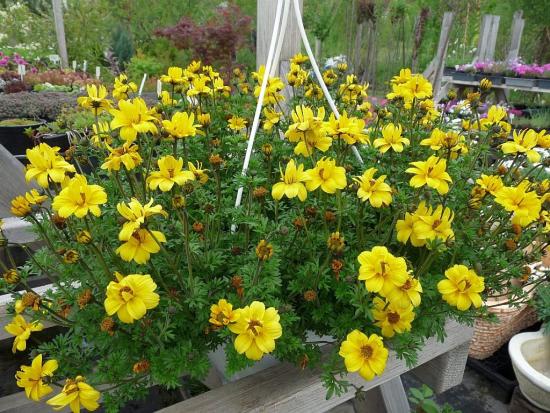
After 9 - 12 days, shoots should appear. If the plants are not planted very often, then you can do without picking. If seedlings are frequent, then after 4 - 5 weeks the seedlings need to be transplanted. You can place 2 - 3 seedlings in one pot. Caring for decorative succession seedlings comes down to watering and fertilizing. The first fertilizing should be done when two to three weeks have passed after emergence.
To do this, you can dilute any phosphorus-potassium fertilizer. In May, seedlings can be bidens transplant to a permanent place. If the soil in the selected area is heavy, then you need to add sand before planting. Its per 1 sq. meter will require 1-2 buckets.
If the plant is planned to be grown in group plantings, then the distance between neighboring bushes should be left at least 30 cm. After the seedlings take root, it is advisable to feed them again. This can be done within 14 days after transplantation. If the timing of the appearance of the first flowers on a decorative row is not important, then it can be sown directly into the ground.
Video about the beneficial properties of string (bidens):
How to sow bidens seeds in an open garden bed
In the southern regions or where the gardener is ready to wait for the decorative series to bloom until mid-July, you can plant bidens directly into the ground. The selected area for planting is dug up immediately after the ground thaws. Most often this happens by mid-April. After digging seeds planted in holes. You can put 3 - 5 pieces in one hole. Shoots appear in about 10 days.
Bidens seedlings in open ground also need feeding two weeks after emergence. Plants sown in the ground will bloom after July 15th.In order for flowering to continue until frost, the plant needs to be given some care.
Caring for bidens ferulefolia
In order for the bidens to have a decorative and aesthetic appearance, and to form a bush that looks like a perfect ball, it needs to regularly pinch out the side shoots. In this case, the bushes will eventually look like bright yellow balls of sunshine. Despite its unpretentious nature, bidens is responsive to application fertilizing. If you provide it with nutritious phosphorus-potassium mixtures every 14 days, it will bloom more profusely and longer.
Sometimes it happens that in the middle of the season the number of inflorescences decreases and disappears. In this case, you need to radically prune the shoots. After this, the active growth of new peduncles begins and bidens restores its decorative effect within a short time.
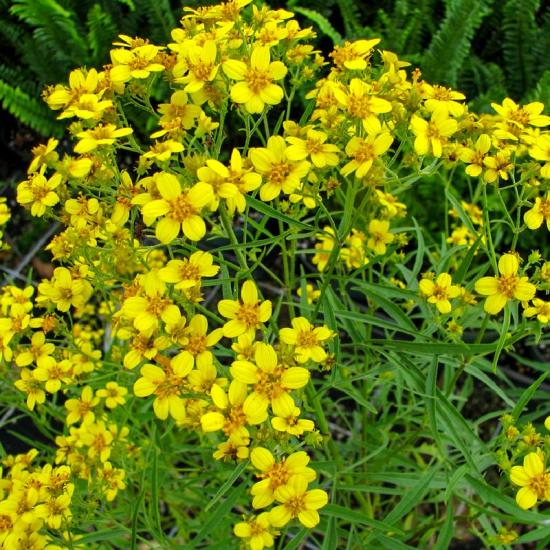
Self-seeding of the decorative series was mentioned above, in order to avoid uncontrolled spread and not to fight the growth of this plant on the site, you need to cut off the fading inflorescences in a timely manner, do not wait until the seeds in them ripen and begin to pour out into the ground. In all other respects, bidens can be called a leader in unpretentiousness and decorativeness among garden flowers.


